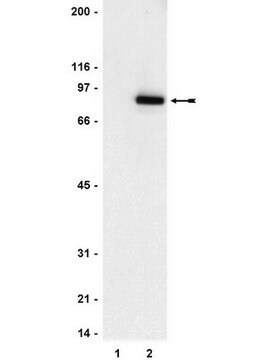MABF2817
Anti-SARS-CoV-2 nucleocapsid NC1 Antibody, clone 6G3-G6
Synonim(y):
Nucleoprotein (UniProt: P0DTC9;also known as N;Nucleocapsid protein;NC;Protein N
About This Item
Polecane produkty
pochodzenie biologiczne
mouse
Poziom jakości
białko sprzężone
unconjugated
forma przeciwciała
purified antibody
rodzaj przeciwciała
primary antibodies
klon
6G3-G6, monoclonal
masa cząsteczkowa
calculated mol wt 45.63 kDa
observed mol wt ~50 kDa
oczyszczone przez
using protein G
reaktywność gatunkowa
SARS coronavirus
opakowanie
antibody small pack of 100 μg
metody
immunocytochemistry: suitable
immunoprecipitation (IP): suitable
western blot: suitable
izotyp
IgG1κ
sekwencja epitopowa
N-terminal half
numer dostępu Protein ID
numer dostępu UniProt
Warunki transportu
ambient
docelowa modyfikacja potranslacyjna
unmodified
informacje o genach
human ... GINS1(9837)
Opis ogólny
Specyficzność
Immunogen
Zastosowanie
Evaluated by Western Blotting in lysate from HEK293T cells expressing SARS-CoV-2-Nucleocapsid NC1 protein.
Western Blotting Analysis (WB): A 1:1,000 dilution of this antibody detected Nucleoprotein NC1 in lysate from HEK293T cells expressing SARS-CoV-2 nucleocapsid NC1, but not in lysates from wild-type HEK293T cells or from HEK293T cells expressing the Spike protein.
Tested Applications
Western Blotting Analysis: A 1:2,000 dilution from a representative lot detected Nucleoprotein in Whole cell lysates of HEK293T expressing the nucleocapsid (NC) proteins of the indicated human coronaviruses (Data courtesy of Dr. Stefan Schüchner, Dr. Egon Ogris, Max Perutz Labs, Medical University of Vienna, Austria).
Immunocytochemistry Analysis: A representative lot detected Nucleoprotein in HeLa cells transiently transfected with SARS-CoV-2 NC-P2A-GFP (Data courtesy of Dr. Stefan Schüchner, Dr. Egon Ogris, Max Perutz Labs, Medical University of Vienna, Austria).
Immunoprecipitation Analysis: A representative lot detected Nucleoprotein in with the indicated monoclonal antibodies from whole cell lysate of HEK293T cells expressing Sars-CoV-2-NC-P2A GFP (Data courtesy of Dr. Stefan Schüchner, Dr. Egon Ogris, Max Perutz Labs, Medical University of Vienna, Austria).
Note: Actual optimal working dilutions must be determined by end user as specimens, and experimental conditions may vary with the end user
Postać fizyczna
Przechowywanie i stabilność
Inne uwagi
Oświadczenie o zrzeczeniu się odpowiedzialności
Not finding the right product?
Try our Narzędzie selektora produktów.
polecane
Kod klasy składowania
12 - Non Combustible Liquids
Klasa zagrożenia wodnego (WGK)
WGK 1
Certyfikaty analizy (CoA)
Poszukaj Certyfikaty analizy (CoA), wpisując numer partii/serii produktów. Numery serii i partii można znaleźć na etykiecie produktu po słowach „seria” lub „partia”.
Masz już ten produkt?
Dokumenty związane z niedawno zakupionymi produktami zostały zamieszczone w Bibliotece dokumentów.
Nasz zespół naukowców ma doświadczenie we wszystkich obszarach badań, w tym w naukach przyrodniczych, materiałoznawstwie, syntezie chemicznej, chromatografii, analityce i wielu innych dziedzinach.
Skontaktuj się z zespołem ds. pomocy technicznej






